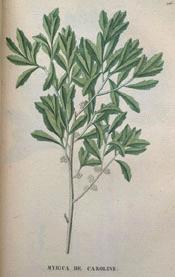

| |
(Myrica cerifera)
|
Bayberry
Botanical: Myrica cerifera (LINN.)
Family: N.O. Myricaceae
---Synonyms---Wax Myrtle. Myrica. Candle Berry. Arbre à suif. Myricae Cortex. Tallow Shrub. Wachsgagle.
---Parts Used---The dried bark of the root. The wax.
---Habitat---Eastern North America.
---Description---The only species of a useful family that is regarded as official, Myrica cerifera grows in thickets near swamps and marshes in the sand-belt near the Atlantic coast and on the shores of Lake Erie. Its height is from 3 to 8 feet, its leaves lanceolate, shining or resinous, dotted on both sides, its flowers unisexual without calyx or corolla, and its fruit small groups of globular berries, having numerous black grains crusted with greenish-white wax. These are persistent for two or three years. The leaves are very fragrant when rubbed.
The bark as found in commerce is in curved pieces from 1 to 7 inches long, covered with a thin, mottled layer, the cork beneath being smooth and red-brown. The fracture is reddish, granular, and slightly fibrous. The odour is aromatic, and the taste astringent, bitter, and very acrid. It should be separated from the fresh root by pounding, in late autumn, thoroughly dried, and when powdered, kept in darkened, well-closed vessels.
The wax was first introduced into medicinal use by Alexandre in 1722. It is removed from the berries by boiling them in water, on the top of which it floats. It melts at 47 to 49 C. (116.6 to 120.2 F.). It is harder and more brittle than beeswax. Candles made from it are aromatic, smokeless after snuffing, and very brittle. It makes a useful body for surgeon's soap plasters, and an aromatic and softening shaving lather. It has also been used for making sealing-wax. Four-fifths of this wax is soluble in hot alcohol, and boiling ether dissolves more than a quarter of its weight. Four pounds of berries yield about one pound of wax.
---Constituents---There has been found in the bark of stem and root volatile oil, starch, lignin, gum, albumen, extractive, tannic and gallic acids, acrid and astringent resins, a red colouring substance, and an acid resembling saponin.
The wax (Myrtle Wax) consists of glycerides of stearic, palmitic and myristic acids, and a small quantity of oleaic acid.
[Top]
---Medicinal Action and Uses---Astringent and stimulant. In large doses emetic. It is useful in diarrhoea, jaundice, scrofula, etc. Externally, the powdered bark is used as a stimulant to indolent ulcers, though in poultices it should be combined with elm. The decoction is good as a gargle and injection in chronic inflammation of the throat, leucorrhoea, uterine haemorrhage, etc. It is an excellent wash for the gums.
The powder is strongly sternutatory and excites coughing. Water in which the wax has been 'tried,' when boiled to an extract, is regarded as a certain cure for dysentery, and the wax itself, being astringent and slightly narcotic, is valuable in severe dysentery and internal ulcerations.
---Dosages---Of powder, 20 to 30 grains. Of decoction, 1 to 2 fluid ounces. Of alcoholic extract, or Myricin, 5 grains.
---Other Species---MURICA GALE, SWEET GALE, ENGLISEI BOGMYRTLE, or DUTCH MYRTLE, the badge of the Campbells. The leaves of this species have been used in France as an emmenagogue and abortifacient, being formerly official under the name of Herba Myrti Rabantini, and containing a poisonous, volatile oil. The plant is bitter and astringent, and has been employed in the northern counties as a substitute for hops, and also mingled with bark for tanning, and dyeing wool yellow. The dried berries are put in broth and used as spices. Formerly it was much used in cottage practice, its properties being similar to those of M. cerifera. It is covered with a golden, aromatic dust, and is thus used to drive away insects. The leaves are infused like tea, especially in China, as a stomachic and cordial. See GALE (SWEET).
M. nagi. A glucoside, Myricitrin, resembling quercitrin, has been separated from the yellow colouring matter, or myricetin.
M. cordifolia, of the Cape of Good Hope, yields a wax which is said to be eaten by Hottentots.
M. Pensylvanica has roots with emetic properties.
A Brazilian species yields a waxy-resinous product called Tabocas combicurdo, which is used as a 'pick-me-up.'
BAYBERRY is a synonym for the Wild Cinnamon or Pimenta acris of the West Indies and South America, which yields Bay Rum and oil of Bayberry.
[Top]
Common Name Index
A MODERN HERBAL Home Page
Purchase this Herb from Botanical.com
Bear in mind "A Modern Herbal" was written with the conventional wisdom of the early 1900's. This should be taken into account as some of the information may now be considered inaccurate, or not in accordance with modern medicine.
© Copyright Protected 1995-2004 botanical.com

|



